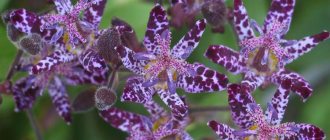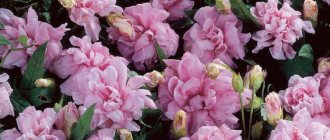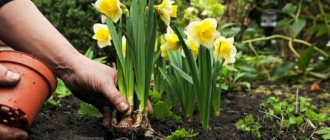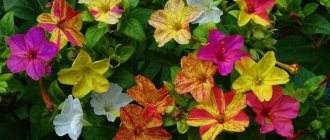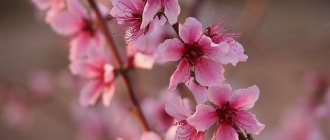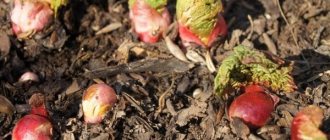Description of the tree
In nature, there are wild and cultivated almonds. The nuts of the wild plant are bitter, and therefore it is better to plant varietal almonds in the garden, whose fruits have a sweet taste.
The tree amazes with its beauty
The average plant has the following characteristics:
- height – from 4 to 6-8 meters
- The root system consists of 5 skeletal roots, which are capable of penetrating to great depths, providing the tree with water from underground sources. Therefore, almonds tolerate arid climates calmly
- shoots are divided into two types - shortened and elongated
- flowers are large – up to 2.5 cm in diameter
- flowering begins in early spring - April or even March. Moreover, flowering occurs before the first leaves bloom on the almonds.
- nuts are from 2.5 to 3.5 cm in length; after drying, the seeds are easily removed from the pericarp
- The first fruiting begins in the fifth year, with good care in the fourth year of life. After another five to seven years, the tree enters full fruiting. The minimum period for a tree to bear fruit is 30 years.
- there are also ornamental almonds , which have the shape of a bush. It is very beautiful - the whole bush is sprinkled with soft or bright pink flowers
Due to its strong sweet aroma, almonds become honey plants during the flowering period. This smell attracts many bees, which pollinate almonds and other plants in the garden.
What does a blooming almond look like?
The lush almond blossom is such a mesmerizing sight that it cannot leave anyone indifferent.
Did you know? World Almond Day, which falls on February 16, is celebrated primarily in the United States, which accounts for 65% of global almond production. Almond Blossom Days are celebrated in Spain and Portugal.
The white-pink cloud that envelops branches that have not yet covered with leaves in early spring against the backdrop of a bright blue spring sky has not escaped the attention of many generations of Eastern poets. In many countries with mild climates, the flowering of almond plants is associated with the beginning of spring.
The flowering branches of this plant have forever entered the world treasury of painting thanks to the famous painting by Van Gogh, which is called “Blossoming Almond Branches.”
Even the ancient Egyptians, the beauty of the blooming almond plant forced them to include almond branches with flowers in magical rituals, the ancient Chinese associated the blooming almond with female beauty, the ancient Romans considered it a symbol of fertility, and the Persians called it the Tree of Heaven.
Did you know? Archaeological research indicates that the almond plant was familiar to people in ancient times. This plant is even mentioned in the Bible.
Where to plant - practical and aesthetic aspects of choosing a location
Considering that almonds grow very tall, they need to be planted where there is space. If you plant it too close to other plants, then over time its crown will shade the entire space around it.
Also, when choosing a place for planting, you need to take into account that this plant bears fruit only with cross-pollination. Therefore, near the first almond you will have to plant at least two or three more almond trees, pollinating varieties. If your neighbors already have almonds, the plants still do not cross-pollinate, since they must be very close to each other.
Tree placement option
The best place to plant a tree is a sunny area (partial shade is allowed), protected from winds and drafts. If a gardener dares to plant almonds in the shade of tall buildings or trees, then the tree’s growth process will be slow and the plant’s productivity will be low.
Soil for almonds:
1 Suitable - black soil, loam or sandy soil. Well air and water permeable, with deep groundwater. The plant feels great on calcareous soils - with a pH value of 7.7.
2 Unsuitable - acidic or saline, chloride or with high groundwater levels.
You also need to make sure that the tree fulfills its decorative role - why hide such beauty from view in the far corner of the garden? A group of 3-5 plants will look great along a fence, which will also protect the trees from the wind.
Decorative almonds in landscape design
The plant decorates the garden, summer cottage. Almond trees with a well-formed, well-groomed crown are suitable for planting in parks and squares. It is helpful to plant several shrubs three to five meters apart to facilitate cross-pollination. During flowering, almonds fill the landscape with bright colors.
With regular pruning and timely feeding, growing decorative almonds is not difficult. By planting a shrub on your site, it will delight you with spectacular flowering for many years and add color to your landscape design.
The video material adds even more useful information about such a popular and highly decorative species as the Almond bush:
Planting in spring and autumn
Experts recommend planting this tree in the fall - at the end of November, they say, in this case it will take root better. Planting is possible even in the first winter months. But, if it’s spring outside, the beginning of March, and you have an almond seedling in your hands, then there is no need to wait until the fall to plant.
10-14 days before purchasing a seedling (or better yet, in the fall for spring planting, or in the spring for autumn planting), you need to prepare a planting hole. This is done so that the ground settles and the plant does not sink too deep after planting.
There should be enough space between plants
The diameter of the planting hole is 50-70 cm, and its depth is approximately 60 cm. If you plan to plant several plants at the same time, you need to ensure that the distance between the holes is at least 3 meters, and between the rows - at least 5.5 meters.
It is advisable to lay a drainage layer at the bottom of the hole from any available materials - broken bricks from construction, expanded clay, gravel. Sprinkle the top of the drainage with sand. The earth removed from the pit needs to be enriched:
- Fertile soil is prepared - sand (1 part), humus or compost (2 parts), leaf (or regular) soil (3 parts).
- Another 5 or 6 kg of humus or compost is added to the soil.
- 500 g of superphosphate is added to the mixture.
- If the soil on the site is too acidic for almonds, you can add 300 g of dolomite flour or lime to the planting mixture to even out the acid-base balance.
This soil mixture is poured into the planting hole, forming a small mound in the middle of the hole. Part of the mixture should be left so that there is something to sprinkle on the roots of the seedling.
It is also advisable to drive a peg that will rise above the ground by at least 50 cm.
Landing technique
After two weeks have passed since the preparation of the hole, almonds can be planted. The optimal age for almond seedlings is 1 year. It should look healthy and have a good and undamaged root system.
Before starting the procedure, the roots of the tree need to be soaked in water. And then dip it into an aqueous solution of clay, which has the consistency of thick sour cream.
Excellent specimen of a plant
The seedling is placed on a mound, taking into account that the root collar is slightly above ground level, and its roots are covered with soil mixture. The tree needs to be gently shaken periodically so that all the air pockets between the roots are filled with soil.
After planting, the soil is compacted and watered with a bucket of water. To prevent the liquid from spreading over the area, you can make a low earthen bank around the tree and pour water inside the circle.
When the water is absorbed, you need to tie the seedling to a peg, and mulch the soil in the tree trunk circle to 5 cm. For this purpose, you can use compost, as it will perform the additional function of feeding the plant. The main thing is to ensure that the mulch does not touch the tree trunk; there should be a couple of centimeters of empty space around it.
Growing bean shrubs: planting, care and pruning (with video)
Bobovnik easily propagates by root suckers, which are dug up, separated from the mother plant and planted in the spring. But it can also be propagated by seeds. When propagating bean plants, freshly harvested seeds are sown immediately in the seedling, and dry seeds are sown in the soil in the spring, after a preliminary three-month stratification in moist soil at home in the refrigerator.
To grow beans, you need to choose a place that is in direct sunlight or, in extreme cases, where there is light shade. It is strictly forbidden to plant a bush in a draft or in a place where the wind is constantly blowing.
Having chosen the right place for planting and caring for the bean tree, take care of preparing the soil. The acidity level should be around 7.5. If you want to create the most favorable conditions for the bush, then make a mixture of components such as leaf soil (3 parts), humus (2 parts) and sand (1 part). Next you need to add lime or dolomite flour at the rate of 300 grams per bush. When planting several bushes, you need to leave a distance of about one and a half meters so that later the plants do not interfere with each other. In each hole you need to create good drainage so that there is no stagnation of water. This can be done using crushed stone or brick fragments, as well as sand. The whole process goes like this:
Dig a hole of such a size that all the roots fit freely into it. First, a drainage layer is placed on the bottom, which should be about twenty centimeters. Five centimeters of sand are poured onto the drainage layer. Fill the prepared soil and plant the bush there so that the neck of the root is above the ground.
These photos show planting and caring for beans in a personal plot:
The plant is exceptionally light-loving, winter-hardy, drought-resistant and undemanding to the soil, responds positively to pruning and tolerates smoke well. Due to its early and beautiful flowering, it is used for group and single plantings.
Low almonds are not afraid of frost or drought, and therefore do not need shelter for the winter and can do without watering all summer. It grows very quickly, forming lush spherical bushes on “legs” with abundant flowering. Starting from the age of three, it produces a lot of root shoots that can be used for propagation. Flowering begins in the 3rd–5th year, and the bean plant enters full fruiting in the fifth year of its existence.
A large amount of root growth prevents the formation of seeds, so it must be regularly removed, leaving only a few of the strongest shoots to replace aging shoots.
When forming a bean tree in the first year after planting, pruning should be minimal. In this case, the shoots are shortened by only 2.5 - 5 cm. Incorrectly located, dried out and diseased branches are also removed. They do this the second year, in the spring. In March or April, last year's growth is severely cut off. Bean pruning is done on developing buds.
In the future, every year in the spring, after low temperatures have passed, the frost-damaged shoot tips are pruned. At the same time, weak, lifeless and incorrectly located growths are removed.
Watch the video “Pruning a bean tree” to better understand how to shape a bush:
What is care?
The tree requires care, especially in the first year of life
If you have very little time to care for the tree, you can limit yourself to pruning and winterizing. But then the almonds will not grow very quickly and you can’t hope for a large harvest.
If you draw up a plan for caring for the plant and carry it out in accordance with the peculiarities of the agricultural technology of this crop, then it will generously thank the owner with delicious fruits.
What to do during spring, summer and autumn:
- watering
- loosening the soil
- crown pruning
- weed, disease and pest control
- fertilizing with organic and mineral fertilizers
- shelter for the winter (for young plants, even winter-hardy varieties are required)
If you want to get your own free almond seedlings, you will have to master propagation methods. But there is nothing complicated in this regard; even an inexperienced gardener can cope. But the seedlings can be planted on your own plot to ensure pollination, distributed to relatives and friends, or sold - young almond trees are several times more expensive than many other fruit trees.
Watering and loosening
The first watering and loosening of the soil near the tree trunk is carried out at the very beginning of March - these procedures open the new season. As soon as the ground thaws, you can water the plants at the rate of 1 bucket/1 tree. There is no need to water anymore, as excessive moisture leads to inevitable rotting of the root collar.
After moistening, the soil in the tree trunk circle is loosened. Loosening improves soil breathability. The first time this is done to a depth of 10-12 cm, and after each subsequent watering during the season - to a depth of 8-10 cm.
Loosening is a desirable procedure in comprehensive tree care
If you don’t want to loosen or don’t have time for it, then mulch the soil around the tree with some durable material. Pebbles or, in extreme cases, tied bundles of hay or straw will do. In this case, the soil will dry out less, will not require constant cultivation, and will not be covered with weeds.
You can water the tree using mulch. It will only have to be removed when fertilizers are applied.
All other waterings during the season are done as the soil dries to a depth of 1.5 cm. If the tree grows on sandy soil, this will happen more often than if almonds are planted on clay or loamy soil. For each watering you will need 1 bucket of water standing in the sun.
Watering recommendations apply to more or less mature trees. In the first year, when the seedling is still young and not adapted to the external environment, it will have to be watered much more often - once every 1.5-2 weeks.
Is it possible to grow a tree in the absence of water?
Such fruits can only be obtained by providing the tree with regular moisture.
When a gardener does not have constant access to water and watering comes only through natural rainfall, almonds are more likely to survive. After all, in nature it is a drought-resistant tree. But lack of moisture leads to inhibition of seedling growth processes.
Due to lack of fluid, almond leaves become dehydrated. When the humidity level drops to 53%, the tree sheds most of its foliage at the beginning of summer.
The lack of foliage causes a halt in the growth of new shoots. All this together leads to an almost complete loss of this year’s harvest, and the next one too. After all, generative buds also practically do not develop.
If there is practically no opportunity to regularly feed the plant with water, at least organize spring and autumn water-recharging watering! To do this, you can first accumulate rainwater in large containers. And in the spring, collect snow before the onset of heat and wait for it to melt.
The best varieties for the Moscow region
The climate of the Moscow region allows you to grow the following varieties:
- three-lobed;
- terry;
- dessert;
- seaside.
These varieties may freeze in winter, but they recover quite quickly and bloom luxuriantly.
Terry is a decorative form of a three-lobed species, which has another name - Louiseania. Dessert and Primorsky varieties are varieties of the common sweet variety. The dessert variety is frost-resistant, the fruits are oval in a soft shell. It is pollinated by the Primorsky variety, so plant it nearby to get a harvest. The Primorsky variety plant blooms in April. The pollinator is Dessert. These varieties are self-sterile - plant two plants close together to get fruit.
We recommend reading about varietal almond trees.
Three-blade
Louiseania is an ornamental shrub that grows up to 3 m in height, has a spreading crown, large-toothed three-lobed leaves, and flowers 1.5 cm in diameter, arranged in pairs. There are two decorative forms of Louiseania:
- Plena. It blooms in May, for 14 days after the leaves have bloomed. The flowers are composed of 40 pink petals 4 cm in diameter.
- Kyiv. Flowering is characterized by a large number of double flowers of pink or dark pink, 3.5 cm in diameter. Each flower has 12 petals.
Louiseania has many hybrid forms that differ in different flower colors and flowering periods.
Did you know? Spain is the leading producer of almonds in Europe and third in the world after the USA and Australia. Export revenue from the sale of 50 thousand tons of this nut is 260 million euros.
Terry
Terry Louiseania (Amygdalus Plena) is a shrub that can reach a height of 2 m. The leaves are three-lobed, wide elliptical, their length is 6 cm. The variety blooms from April to May, for 3–5 weeks. The flowers are double, bright pink, their diameter is 3 cm.
Louiseania terry looks very beautiful both as a single plant and in a group. It is used for landscape design of rocky hills and forest edges.
Dessert
Bred in Crimea by crossing Nikitsky-62 and Nikitsky-1. Dessert lends itself to the formation of both shrub and tree crowns. The drupes are large and ripen in September. When the tree reaches nine years of age, its yield is up to 7.6 kg of dry kernels per season.
Around April, the bushes are covered with a pink cloud of flowers. The height of the bushes reaches 5 m, the crown is rounded. The variety is frost-resistant, flower buds are not damaged by returning spring frosts. The fruits are sweet and contain a lot of oil and trace elements.
Did you know? Traditional medicine uses almonds as a remedy for pain, cramps, coughs, as well as to eliminate symptoms of anemia, and even to treat insomnia.
The Dessert variety is characterized by:
- persistent period of rest;
- relatively late flowering period;
- weak damage to diseases and insects.
Seaside
The variety was developed on the Crimean Peninsula by crossing two hybrids - Nikitsky-53 and Princess-2077. The variety is characterized by late flowering and a long dormant period. The trees are short with a spreading dense deciduous crown, grow up to 3.5 m, resistant to fungi. Large round drupes ripen in September, 2–6 pieces each. in a whole soft shell. A harvest of up to 15 kg is harvested from one tree. The leaves are oblong, large in size, their color is dark green.
Crown trimming
Trimming the almond crown is a mandatory procedure if the gardener expects a high yield. The fact is that the thickened crown shades itself, that is, the shoots inside the crown and at the base of the skeletal branches. With a lack of light, these shoots simply dry out.
As a result, the harvest can only be harvested where the branches are well lit - at the ends of the shoots along the periphery of the crown.
This pruning option is suitable not only for apple trees, but also for our tree
Pruning begins from the second year of the plant’s life on the garden plot. Firstly, after wintering, almonds may need sanitary pruning, in which all “bad” shoots are removed - broken, diseased, dry, frostbitten. At the end of the season, similar sanitary pruning of all damaged or infected shoots is done.
Almonds respond well to pruning, including when the gardener trims shoots for bouquets in the spring.
Secondly, the most important pruning is formative. All skeletal branches need to be formed in the second year of the plant’s life. Or at least try to do it.
Crown formation
Rules for crown formation
The formation of the crown occurs as follows:
- The gardener determines for himself the optimal height of the trunk - that is, the height from which the growth of branches begins. All shoots below must be cut into a ring, that is, without leaving a stump.
- Of all the low-lying shoots, the first skeletal branch in terms of number and height is selected. For this role you need to choose the strongest and most developed shoot from the lower ones.
- The second skeletal branch is the one located 10-20 cm above the first and directed in the opposite direction.
- The third skeletal branch is the one that grows 10-20 cm above the second and is directed perpendicular to the previous two.
- All other branches that are in the area of three skeletal branches are cut into a ring.
- To control the tree's upward growth, you can shorten the center conductor. It should rise 50-60 cm above the last branch.
In the future, the gardener must ensure that the young shoots that will appear as the tree grows do not thicken the space inside the crown. And also so that they do not compete with the main one, that is, they are not stronger and more developed than the skeletal ones and the conductor itself.
When cutting thick branches, the cut site should be treated with garden varnish to help the plant recover.
Weed, disease and insect control
Leaf roller and its work
The problem with weeds can be solved by mulching the soil or using biological products, timely manual or mechanical removal of all weeds.
Regarding diseases, almonds are most often susceptible to the following diseases:
- Cercospora blight . Characteristic features are the appearance of small brown spots, drying out of the center of the leaf and its falling off.
- Scab - leaves, flowers, and shoots of the tree are affected. A disease of fungal etiology.
- Rust - the appearance of red spots on the outside of the sheet and brown seals on the inside. Sooner or later the leaves dry out and fall off.
- Hole spot - the disease affects all structural elements of the tree. Spots of a reddish hue and with a darker border appear on the leaves.
- Gray rot - leaves become covered with brown spots, on which you can see a gray coating that is soft to the touch.
Prevention and treatment of almond diseases involve treatment with fungicides. For this purpose, you can purchase the products “Topaz”, “Champion”, “Skor”, “Fundazol”.
The insects that attack almonds are common pests that also attack other plants in the garden - aphids, leaf rollers, spider mites. If infection has already occurred, the tree will need to be treated with insecticides. For example, “Aktellik”, “Fitoverm”, “Tagore” are effective.
If you are already processing almonds, do not be too lazy to spray the neighboring plants, they most likely either became infected from the almonds, or were initially a source of infection for them.
How to prevent infection by pests and microorganisms
Bordeaux mixture as a preventative measure
In order not to fight pests and diseases, and not to risk the health of the plant and the harvest, you need to take preventive measures:
1 In early spring, even before the buds begin to bloom, the plant must be treated with a solution of Bordeaux mixture. The solution should be one percent, and it is not recommended to apply it to blossoming buds, so as not to damage them. You can also cultivate the ground under the tree. In this way, you can get rid of pests that have overwintered in the bark or soil of the tree trunk.
2 In the fall, when the growing season ends and the plant sheds its leaves, the treatment must be carried out again. This is done in order to eliminate all pests that could spend the winter on the tree or in the soil under it.
Instead of Bordeaux mixture for spraying, you can use chemical or organic preparations similar in principle of action.
Types and varieties of almonds with photos
- Triloba almond (Louisiania triloba) – spreading crown. Its height sometimes reaches 3 meters. The leaves have large teeth along the edges. Their surface, when they open, has a fleecy structure. The flowers are small.
Three-blade
- Rosemund almond - blooms for quite a long time with pink double flowers of miniature size.
- Tanyusha almonds are double flowers with curled petals. Flowers - 2.5-3.5 centimeters.
- Stonefly almonds are disease resistant. Known for its decorative properties.
Almond Vesnyanka
- Georgian almond - grows on the edges and in hollows. Its height is 1 meter. The length of the leaves is 8 centimeters. The flowers are big. This almond is winter-hardy. It is often used by breeders.
- Ruslana almond is a hybrid. Flesh flowers turn almost white when finished.
https://www.youtube.com/watch?v=bFFrq9ps2IU
Fertilizer application
Almonds do not require frequent fertilization. While the tree is young, you can feed it 2 times a year - in spring and late autumn. And a newly planted seedling does not need to be fed at all in the first year of life, because the fertilizers that the gardener added to the planting hole will be enough for it.
In spring it is necessary to apply nitrogen fertilizers
Almond feeding is carried out according to the following scheme:
1 In the spring, before the first watering and loosening, nitrogen fertilizer is applied to the tree trunk circle. You can use saltpeter for this, at the rate of 20 g of the drug per 1 bucket of water.
2 In the fall, when the site is being dug up, a complex of fertilizers is added to the almond tree trunk - 1 kg of compost or humus, 20 g of potassium sulfide, 20 g of double superphosphate.
Shelter for the winter
Shelter during the cold season is necessary for all plants, regardless of age or place of growth of almonds. If the garden is located in the southern zone, insulation for almonds is not so critical, but it is still better to take care of young seedlings. Of course, if the tree has already grown 4-6 meters, it will not be possible to cover or insulate its branches, but you can try to take appropriate measures regarding the trunk.
All that remains is to stretch the insulation onto the frame - the bush will not freeze
Experts recommend insulating even frost-resistant varieties, such as Almond Stepnoy, also known as Low, Russian, Bobovnik, or Almondnik. Some varieties of this frost-resistant species are bushes rather than trees, but this does not make the taste and benefits of the fruit worse.
To protect the plant from the cold, you can take the following measures:
- In early August, remove the apical buds on the shoots. In this way, it will be possible to accelerate the lignification of the shoots and they will better withstand frost.
- Cover young (required) and mature (highly desirable) plants 15 cm or higher with breathable material - tufts of straw or a bunch of dry leaves. You just need to make sure that the covering material is not diseased, since humidity during a thaw or in early spring can contribute to the infection of the tree with pathogenic microorganisms. With the first snow, you can begin to form snowdrifts around tree trunks.
If the crown of young trees consists of relatively bendable shoots, they can be collected “in an armful,” tied with twine and wrapped in agrofibre. You can try to throw lutrasil on a more spreading and more elastic crown.
Reproduction
Obtaining seedlings at home
Depending on the type and variety of the plant, there are several ways to propagate almonds:
- Seedling is a long process that many gardeners “throw away” halfway through. But it is an excellent option for growing rootstocks for grafting high-value almond varieties.
- Cuttings are the best option for almonds that grow as a tree.
- Layers and shoots - for bush almond species.
Each gardener chooses the method of plant propagation that suits him best, but the fastest is through cuttings and layering.
Bones or seeds
Almond seeds
Propagation of almonds using its fruits can be done in two ways.
1 The first is the natural stratification of seeds and plant germination in open ground conditions. In this case, you need to plant the seeds (nuts) of the tree after they ripen. Ideally, you should wait until the nuts fall to the ground and plant them in a convenient location before winter.
In this way, the seeds will stratify and germinate and develop without any participation from the gardener. The disadvantage of this method is that almond seeds can be eaten by rodents during the hungry winter months. And if the animals don’t eat it, the seeds will germinate in 1-1.5 years, not earlier.
Strong sprouts are obtained from stratified material
2 The second method is stratification and germination at home. Suitable for those gardeners who prefer to keep the growth process of seedlings under control. In order to plant nuts in the spring, they need to be collected in the fall and placed in the skins in the bottom drawer of the refrigerator.
When the snow melts and the ground thaws, you need to plant seeds stratified in the refrigerator. To do this, you need to make grooves 10 cm deep, the distance between the grooves should be from 45 to 65 cm. Seeds are planted in the groove, maintaining a distance of 10 linear cm between them.
Such seedlings will germinate approximately in April of the following year after planting. They will need to be well looked after - protected from weeds, watered, loosened the soil during planting.
In July, it will be possible to check the seedlings for suitability for planting in a permanent place (varietal varieties) or replanting and carrying out the procedure for grafting cultural cuttings.
Which seedlings can be grafted with cuttings:
- seedling growth in July – 50-60 cm
- the diameter of the seedling trunk in the area of the root collar is about 1 cm
- the seedling was transplanted to a permanent place and has taken root well
All lateral shoots that grow in seedlings at a distance of 10-12 cm from the ground are cut into a ring, then grafted.
Vaccination
Wild or bitter almond seedlings can be used as a rootstock, but not only them. Gardeners often copulate almonds with plum, cherry plum and sloe seedlings. The latter plant has good winter hardiness, so it is excellent for grafting an almond variety that is not very adapted to cold weather.
Grafting is done in the middle of the sap flow process - at the beginning of spring or after flowering/fruiting - at the end of summer. The right time for vaccination is a cool day, early morning or after 4 pm.
Reproduction by grafting
2-3 days before the grafting procedure, the rootstock is watered abundantly and regularly to ensure good separation of the rootstock bark from the wood. It is preferable to choose strong and straight shoots as a scion. Their vegetative buds should be well developed.
Before grafting, it is necessary to provide the scion with conditions for minimal moisture loss. To do this, all the leaves on the branch must be carefully removed, leaving only petioles 1 cm long.
Vaccination procedure
It is clear that the scion has taken root
The vaccination procedure itself is carried out as follows:
- Wipe the stamp from dust with a damp cloth, you can first dip it in an antiseptic solution.
- Using a sharp knife in the area of the root collar, an incision is made in the bark in the shape of the letter T.
- At the point where the cut lines meet, that is, in the center of the cut, the bark is carefully folded back, exposing the wood. Or you can simply make an oval shallow notch in the wood of the rootstock.
- The shoot intended to serve as a scion is cut off under the lower bud. The cut should have an oval shape, matching the shape of the cut on the scion.
- Trying not to touch the cuts with your hands, both parts of the scion and rootstock need to be joined, and then fix the “structure” in this position with tape, electrical tape, adhesive tape or other fixing materials. It is important when wrapping not to cover the kidney itself.
If after a couple of weeks the grafted shoot does not have any signs that it has taken root, except for a green bud, this is normal. All growth that appears above or below the scion must be removed in a timely manner. The tape can be removed from the grafting site when young shoots emerge from the grafted branch.
By shoots or layerings
In this case, we are talking about the propagation of a bush plant variety. After pruning and with abundant feeding, the almond bush begins to form basal shoots. You need to wait one year until the root system of the shoots becomes strong enough, after which the shoots can be dug up and transplanted to a permanent place.
Reproduction scheme by layering
Bush almond varieties can also be propagated by layering - this method is very simple, even amateur gardeners can use it. Flexible almond branches that quietly spread along the ground need to be bent close to the soil and secured with metal brackets. And sprinkle a 20-centimeter ball of soil on top of the branches.
The roots of the cuttings form slowly but surely. Especially if the soil is watered and loosened. After 1-2 years, the cuttings can be divided by cutting them off from the mother bush and transplanted to a permanent place in the garden.
Is it possible to grow almonds from a seed (nut)?
You can only sprout raw, unroasted almonds. According to the regulations for the sale of this product, nuts must undergo a pasteurization procedure to reduce the risk of salmonella contamination for consumers. It's worth noting that even if almonds are sold unroasted, they are still processed. This fact must be taken into account when sprouting nuts purchased in a store, since pasteurization can prevent almonds from sprouting.
The only way to sprout almonds at home is to purchase really raw seeds from a farmer or someone else who has an almond tree. It is unlikely that even a decorative almond tree will be grown from nuts purchased in stores.
Harvesting and storage, benefits and harms
When harvesting, you need to try not to damage the new developing buds. The collected fruits must be cleared of the pericarp on the same day. Nuts must be dried in the fresh air or in a well-ventilated room. Almonds should be stored in a dry linen bag in a dry, well-ventilated place.
After collecting the fruits, you need to clean them from the pericarp.
Almonds are an alternative source of protein and are also an excellent source of vitamins and other nutrients. Its consumption has an antioxidant and general health effect.
But almonds also have negative qualities - they can be a powerful allergen, and also contribute to obesity in people with large body weight. In addition, green almonds should not be consumed categorically - they contain the poison cyanide.
